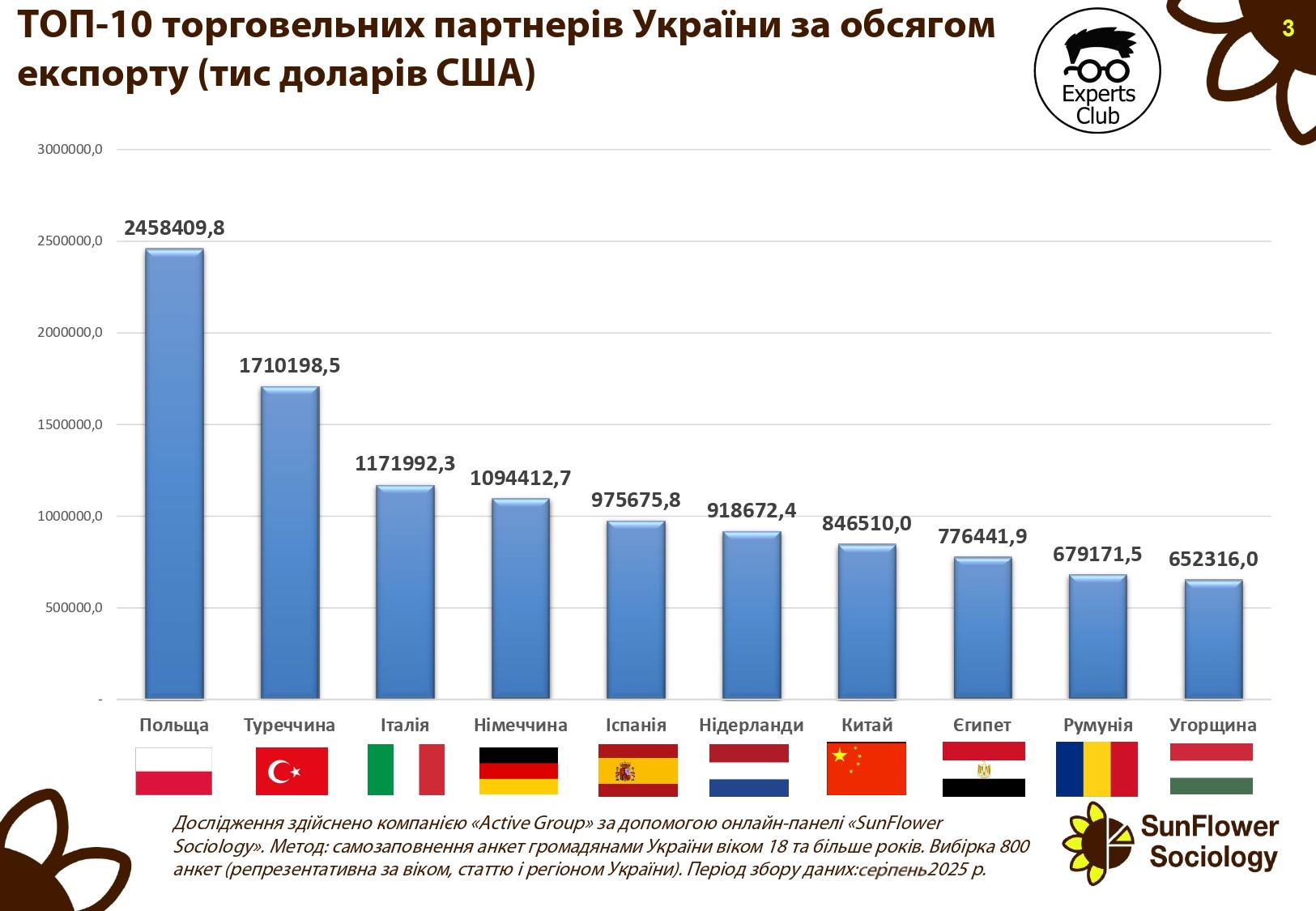
In terms of total trade volume, Ukraine cooperates most closely with China, Poland, and Germany. These countries form the basis of the state’s foreign economic relations, exerting a critical influence on imports and exports.
China remains the leader with a total trade volume of $8.99 billion. Poland ranks second with $6.04 billion, while Germany and Turkey are almost equal with $4.28 billion and $4.25 billion, respectively. The United States ranks fifth with $2.86 billion.

The top 10 also includes Italy ($2.38 billion), the Czech Republic ($1.64 billion), Bulgaria ($1.54 billion), Hungary ($1.53 billion), and Romania ($1.50 billion).
“The top ten partners form the basis of Ukraine’s foreign trade balance. China and the EU countries account for the largest volumes of trade, but it is important to take into account the significant negative balance in relations with these countries,” said Maksim Urakin, founder of Experts Club and economist.
He added that although the large volume of trade indicates Ukraine’s integration into global supply chains, dependence on imports from China and Europe creates strategic risks.
“Poland and Germany are key hubs for Ukrainian exports, but at the same time they are significant sources of imports. Therefore, it is critically important to balance trade flows, preserving positive sectors such as agriculture and metallurgy, and reducing dependence on critical imports,” Urakin noted.
BULGARIA, CHINA, CZECH REPUBLIC, ECONOMY, EXPERTS CLUB, FOREIGN TRADE, GERMANY, HUNGARY, ITALY, POLAND, ROMANIA, TURKEY, UKRAINE, USA, МАКСИМ УРАКИН

According to the results of the first half of 2025, Poland remains Ukraine’s main trading partner in terms of export volumes. According to research by Active Group and Experts Club, exports to Poland amounted to US$2.45 billion.
Turkey ranks second with USD 1.71 billion, and Italy ranks third with USD 1.17 billion. Other major partners include: Germany ($1.09 billion), Spain ($976 million), the Netherlands ($919 million), China ($847 million), Egypt ($776 million), Romania ($679 million), and Hungary ($652 million).

“The structure of Ukraine’s exports shows a clear focus on European Union countries. Poland, Italy, Germany, Spain, and the Netherlands together account for more than half of total exports. This indicates Ukraine’s strategic integration into the European economic space,” emphasized Maksim Urakin, founder of Experts Club and economist.
He also noted that Turkey remains a critically important partner for Ukrainian agricultural and metallurgical exports, while China and Egypt are key markets for agricultural products, particularly grains.
“The presence of trading partners such as Egypt and China diversifies Ukrainian exports,” Urakin added.
CHINA, ECONOMY, EGYPT, EXPERTS CLUB, EXPORTS, GERMANY, HUNGARY, ITALY, POLAND, ROMANIA, TRADE, TURKEY, UKRAINE, МАКСИМ УРАКИН


Italy traditionally enjoys a high level of trust among Ukrainians, combining cultural proximity and pragmatic economic cooperation. This is evidenced by the results of an all-Ukrainian survey conducted by Active Group in cooperation with the Experts Club information and analytical center in August 2025.
According to the survey, 57.3% of Ukrainian citizens have a positive attitude towards Italy (41.7% – mostly positive, 15.7% – completely positive). Only 2.3% of respondents expressed a negative attitude, while 38.7% remain neutral. Another 2.0% said they did not know enough about the country.
“For Ukrainians, Italy is associated with a warm culture, support during the war and significant diaspora contacts. But an even more important factor is the economic one: in the first half of 2025, the total trade between Ukraine and Italy amounted to more than $2.38 billion, of which exports from Ukraine amounted to $1.17 billion and imports from Italy to $1.21 billion. The negative balance of $40 million is insignificant and indicates a relative balance of economic relations,” said Maksym Urakin, founder of Experts Club.
In turn, Alexander Poznyi, co-founder of Active Group, emphasized that the positive attitude of Ukrainians goes beyond economic calculations.
“For most citizens, Italy is also a country associated with cultural openness, historical ties and solidarity in difficult times. That is why more than half of Ukrainians demonstrate a positive attitude, and the low level of negative assessments confirms the friendly nature of relations. In the future, this creates preconditions for even closer cooperation in both political and economic dimensions,” he added.
The survey was part of a broader study of international sympathies and antipathies of Ukrainians in the current geopolitical environment.
The full video can be viewed here:
https://www.youtube.com/watch?v=YgC9TPnMoMI&t
You can subscribe to the Experts Club YouTube channel here:
https://www.youtube.com/@ExpertsClub
ACTIVE GROUP, DIPLOMACY, EXPERTS CLUB, ITALY, Poznyi, SOCIOLOGY, TRADE, URAKIN

The Italian government plans to restrict the presence of Chinese investors in key companies to avoid possible tensions in relations with the US, Bloomberg reports, citing informed sources.
The plans concern companies that the government considers strategic, both private and state-owned, the sources said. One of the most notable examples is Italian tire manufacturer Pirelli & C. SpA, 37% of which is owned by Chinese state-owned Sinochem International Corp.
Earlier this year, Pirelli stripped the Chinese investor of its management control after facing the threat of sales restrictions in the US, its main market. As reported, Washington has banned the import or sale in the country of connected cars that use Chinese equipment or software.
Sinochem insists that its investment in Pirelli is long-term, while Rome is considering options to pressure the Chinese investor to sell its stake, sources say.
The situation surrounding Pirelli shows the difficulties Europe faces in the new geopolitical reality. The region welcomed Chinese investors after the 2008 financial crisis, but now seeks to reduce its dependence on Beijing in order to protect strategic industries and maintain good relations with US President Donald Trump.
Among other companies from which Italy would like to oust Chinese investors is CDP Reti SpA, which controls the country’s power grids, sources say. A subsidiary of State Grid Corporation of China owns 35% of CDP Reti and has two seats on its board of directors.
Another example is power plant manufacturer Ansaldo Energia SpA. Although Shanghai Electric has already reduced its stake in the company from 0.5% to 40%, the very presence of a Chinese investor prevents the company from participating in a number of tenders and competitions in the US energy market, according to one of the sources.
In total, about 700 Italian companies have Chinese investors, but the government is mainly focused on large firms in strategic sectors, including energy, transport, technology, and finance.

Denmark and Germany have agreed to participate in the new format of arms supplies to Kyiv proposed by US President Donald Trump, while France, Italy, the Czech Republic, and Hungary have refused, Western media reported on Wednesday.
In addition, Bloomberg reported on Wednesday that Europe increasingly feels the need to end its dependence on US weapons.
“Europe is heavily dependent on the US defense industry. However, due to trade tariffs, President Trump’s attitude toward NATO and his lack of commitment to defending the alliance’s countries, European countries will increasingly prioritize investments in their own defense systems,” the agency’s sources said.
According to the European portal Politico, France has refused to participate in the purchase of American weapons for Ukraine. The publication’s sources said that instead, the government intends to focus on increasing its own defense budget, which President Emmanuel Macron promised last weekend to almost double by 2027 compared to the 2017 budget.
In addition, Paris wants to support European manufacturers who previously supplied Ukraine with anti-missile systems and other weapons.
Italy also has no plans to purchase weapons from the US for delivery to Ukraine, but will continue to provide military assistance to Kyiv. Unnamed representatives of the Ministry of Defense told the newspaper La Stampa that there had never been any talks about purchasing American weapons for Kyiv.
In addition, the newspaper notes that Italy does not have the funds to carry out operations of this kind. According to the newspaper’s sources, the problem is so acute that the only purchase from the US planned by Italy for the next ten years is a batch of F-35 fighter jets for its own needs.
The Czech government, in turn, said that military aid to Kyiv would continue, but through participation in other initiatives and purchases from Czech, not American, manufacturers.
Hungarian Foreign Minister Péter Szijjártó said that Budapest does not intend to participate in the purchase of American weapons for Ukraine.
Berlin and Copenhagen have so far given their official consent to purchase weapons from the US. Danish Foreign Minister Lars Rasmussen said he was fully prepared to join the funding.
The Dutch Foreign Ministry, in turn, said it was considering participating in the program. However, despite the government’s positive assessment of the initiative, Amsterdam has not yet confirmed its commitment to direct participation.
According to NATO Secretary General Mark Rutte, Sweden, Norway, and the United Kingdom are also expected to join the funding.
On July 11, Trump announced that US NATO allies would purchase weapons from Washington, which could then be transferred to Ukraine.
During a press conference with Trump on Monday, Rutte called it “logical” that European countries would pay for US arms deliveries to Ukraine.
European diplomacy chief Kaja Kallas said on Tuesday that EU countries would prefer Washington to provide part of its military aid to Ukraine free of charge. “If we pay for these weapons, it means that we, not the US, are providing this military aid,” Callas said at a press conference in Brussels. She stressed that Brussels “would like to see these costs shared.”

Italy intends to sign an intergovernmental agreement with Ukraine for EUR 50 million to purchase Italian goods and services for recovery and allocate EUR 100 million to the ERA (Economic Resilience Action) of the International Finance Corporation (IFC) of the World Bank Group to support the private sector, Italian Finance Minister Giancarlo Giorgetti said.
“I would like to emphasize that all these initiatives will be financed from new grant resources, with the clear intention of not placing an additional burden on Ukraine’s state budget,” he said at the URC2025 Ukraine Recovery Conference in Rome, according to a correspondent from the Interfax-Ukraine news agency.
The minister also announced an additional contribution of EUR 10 million for the implementation of an EBRD project in the agro-industrial sector, which aims to modernize Ukraine’s agro-industrial sector while promoting its integration into global value chains.
In addition, Giorgetti stressed the importance of technical cooperation as a basis for effective and sustainable reconstruction and announced his intention to allocate EUR 1.5 million to the European Bank for Reconstruction and Development (EBRD) initiative FIRST (Ukraine Facility for Infrastructure Reconstruction) to assist in the preparation of public investment projects for the reconstruction of infrastructure facilities in Ukraine.